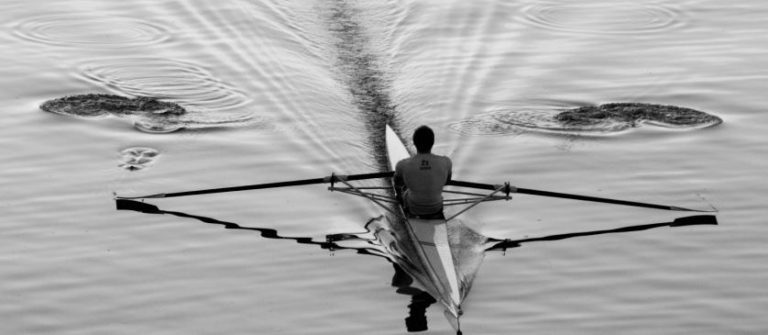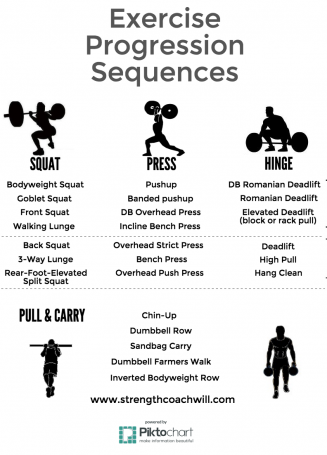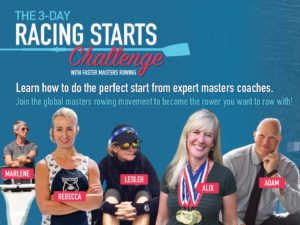The previous excerpt from “Rowing Stronger” discussed training and strength training at a broad level for masters rowers with topics of recovery, exercise progression, and injury prevention. After I got a shout-out from renowned
masters coach Marlene Royle on a recent Rowing Chat podcast I received several questions from masters rowers about specifics of strength training and how to start training if you are 50+ years old and have never really lifted before. Here’s my advice for how to start strength training for a male or female masters rower.
I think that Marlene’s opinion of strength training in her podcast was spot on. Strength training is a vitally important part of masters training, especially for injury prevention, but it is small in comparison to technique, aerobic endurance, and ability on the water and on the ergometer. If you aren’t technically sound on the water or on the erg, you won’t be able to display the full potential of your strength. However, if you’re a masters athlete who has spent a lot of time in the sport, developed great technique and aerobic base, but hasn’t been seeing improvement, strength training could be the missing ingredient. Read the first chapter of Rowing Stronger for free to see why training endurance from the top-down with strength work is so effective.
Getting started with weight training for rowing
Technique is the first thing I emphasize with an athlete of any age. Technique is important to develop the movement patterns that will help you both in and out of the boat. I’d suggest working with a personal trainer or qualified coach on lifting technique, because it isn’t intuitive or natural to a lot of people and there are many ways to go wrong when learning a new skill. You can take this article to a personal trainer or qualified coach so they can teach you the proper technique on these simple exercises.
Strength coach and author Dan John has five basic categories of movement and structures training around those five categories: squat, hinge, push, pull, and carry. For rowers, I would change “carry” to “move” and focus on doing something without your feet strapped in, like hiking, jump rope, a pick-up game, or some other activity that forces you to move your feet independently of each other in a dynamic environment, but if you have the desire and the equipment, something like a sandbag carry or farmers walk would be fine here too.
Rather than link to all of these exercises individually, I’ve put them all into a youtube playlist. Click here for the playlist of all the exercises.
Squat
Start out with just the basic bodyweight squat. Master the movement and then move on to the goblet squat. This may be as much weight as you ever need to use, as you can get a lot out of this without ever needing a barbell. I think single leg squats like step-ups or split squats have a lot of utility for rowers, but they are more difficult.
Deadlift
Master the hip hinge before adding weight with a dumbbell Romanian deadlift. If you desire, you can progress to deadlifting from the floor with a barbell, but it’s by no means necessary. You can fully develop the muscles of the hamstrings, glutes, and back with the Romanian deadlift. The hinge muscles help your posture both in the boat and out and restore a common rowing imbalance of the thigh muscles being stronger than the posterior muscles, often a leading cause of back pain. Learning to hinge will also help your reach on the recovery as each repetition in the weight-room is also a mini stretch for the hamstrings.
Push
The most basic push movement is the bodyweight pushup. If you grew up under the influence of Jack LaLanne, maybe you can go straight to regular pushups. If not, you can scale this movement by elevating your hands on a platform or bench or doing pushups from your knees. If bodyweight pushups become too easy, you can add some resistance with a weighted vest or light band or move on to the dumbbell bench press. Again, a barbell may never be necessary for you.
Pull
My go-to pull exercises are simple exercises for back muscles critical to posture that rowing also under-develops. Batwings and Band Pullaparts are the first exercises that should be mastered here. YWT Raises and X-Band Rows are also great for rowers and can often be very effective with a low amount of weight.
Core
Core training is an important part of a rowing program. Basic bracing exercises of the Plank and Pallof Press are great at teaching torso tightness without stressing the spine (like a situp or crunch). Many masters rowers have some amount of back pain, so the goal is to find exercises that not only don’t aggravate the pain, but will also alleviate the pain in the long term. I prefer to focus on stability in core training rather than movement, training for a braced torso at the catch to provide good connection through the stroke.
How to begin your training program
Start simply and find the minimum effective dose. Marlene’s recommendation of a half hour twice a week is spot on. These basic exercises should help you move better, feel better, and row better and could be enough on their own without needing to progress to heavier or barbell movements.
Here are two sample 30-minute workouts for a beginning masters rower.It’s not a circuit, so finish the first exercise before you move on to the next one. After you warm-up you’d do all 5 sets of 5 bodyweight squats in Workout A before moving on to the Pushup and Batwing. Those are marked 3a and 3b so they can be done as a “superset,” which means no rest between exercises. As a final note with strength training, you want to keep the goal the goal. If you’re training for strength, you should have at least two minutes of rest in between sets so you are fully recovered for each set. While you may be tempted to drop the rest to get through the workout faster, this will generate more fatigue, lessen the amount of weight you can use, and turn a strength workout into more of an aerobic workout. Keep the goal the goal and enjoy faster on-water times!
Workout A
- Warm-Up: 5-10 minutes of light aerobic activity
- Bodyweight/Goblet Squat: 5 sets of 5 repetitions
- Elevated Pushup: 3 sets of 5-8 repetitions
- Batwing: 3 sets of 12-15 repetitions
- Dumbbell Romanian Deadlift: 4 sets of 5 repetitions
- Pallof Press: 4 sets of 8 repetitions each side
Workout B
- Warm-Up: 5-10 minutes of light aerobic activity
- Step Up: 3 sets of 8-12 repetitions each leg
- 3Elevated Pushup: 3 sets of 5-8 repetitions
- 3Band Pullapart: 3 sets of 12-15 repetitions
- Dumbbell Romanian Deadlift: 3 sets of 8-10 repetitions
- Plank: 3 sets of 15 seconds
Will Ruth is the author of www.strengthcoachwill.com and of “Rowing Stronger: Strength Training to Maximize Rowing Performance.” “Rowing Stronger” is Rowperfect’s #1 bestselling e-book and companion DVD available right here in the e-shop and will teach you everything you need to know to create, customize, and execute a strength training program for rowing performance and injury prevention. Will is a former rower and current strength coach for the Western Washington University men’s club team. Check out www.RowingStronger.com for weekly articles about rowing training, strength training, mobility, and sport psychology.









This Post Has One Comment
This is my first time pay a visit at here and i
am truly impressed to read all at alone place.